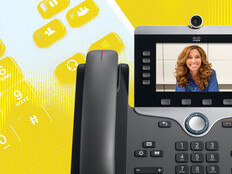How Technology Solutions Can Enable Safety at Work
With this data in mind, it’s worth exploring recent innovations already being implemented to ensure employee health and safety in the workplace.
Environmental Sensors: The addition of sensors to rooms has allowed an increased level of safety for employees. Sensors can read a room and collect data on room temperature, humidity, air quality and light. In addition, these sensors can track the number of people in each room to ensure compliance with room capacity limits.
Room Navigation: Purpose-built devices that contain the above sensors can be used outside of meeting rooms to allow for safe room booking for employees, while also collecting data for IT and facilities managers. These devices provide a simple and contact-free way for employees to find and book a meeting space when they need it, with the added touch of voice activation — so physically touching a screen is not necessary. In addition, when the device is inside a meeting room, it’s able to collect data and provide alerts for things such as social distancing and cleaning schedules.
Control Hub: With all of this new technology collecting data, employees now have the ability to take an in-depth look into workplace analytics through a control hub that provide insights into room utilization and room environment metrics. For example, employees can see whether a room is booked but not used, the median occupancy across all spaces and ambient noise levels.
MORE FROM FEDTECH: Find out how agencies can disinfect IT equipment.
Ensuring a Solid Remote Work Experience
While these innovations will help ensure a safe return to the office in the future, many employees will continue to work from home either permanently or on a part-time basis, as the survey indicates.
Data from the survey shows that 27 percent of government employees anticipate working from home four to seven days per month once offices fully reopen, and 21 percent anticipate doing so eight to 15 days per month. The ability to attend video meetings while working from home is imperative to telework, but many employees voice frustrations when it comes to the technology. Poor audio, background noise from other meeting participants and too many people talking at once are the top frustrations of government employees.
How can agencies address these concerns and improve employee experience when working remotely? Some organizations are already implementing technology to quell these frustrations, including technology within videoconferencing platforms that can:
- Silence background noise and enhance the speaker’s voice so you’re able to hear more clearly
- Hide nonvideo participants
- Enlarge the view of your own screen
- Provide a simple, clean platform design that puts controls in the most logical place
The COVID-19 pandemic has started a work-from-home trend that appears to be the new normal, even for federal agencies and government workers.
We’ve seen numerous innovations just this year in terms of improving both the in-office and remote work experience, and next year is sure to bring about even more technological advancements. Out with the old and in with the new: The hybrid workforce is here to stay.
LEARN MORE: Discover how to prepare technology in advance of a virtual meeting.











